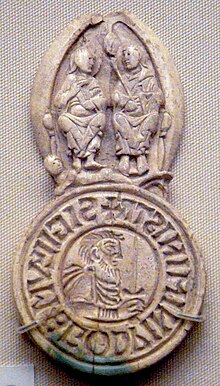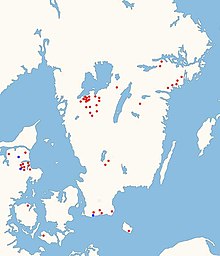Thegn

In laterAnglo-Saxon England,athegn(pronounced/θeɪn/;Old English:þeġn) orthane[1](orthayninShakespearean English) was an aristocrat who owned substantial land in one or more counties. Thanes ranked at the third level in lay society, below the king andealdormen.[2]Thanagerefers to the tenure by which lands were held by a thane as well as the rank.
The termthanewas also used inearly medievalScandinaviafor a class of retainers, andthanewas a title given to local royal officials in medieval easternScotland,equivalent in rank to the child of anearl.
Etymology
[edit] |
| Cyning(king) |
| Ealdorman(Earlafter c.1000) |
| Hold/High-reeve |
| Thegn(thane) |
| Thingmen/housecarl(retainer) |
| Reeve/Verderer(bailiff) |
| Ceorl(churl, free tenant) |
| Villein(serf) |
| Cottar(cottager) |
| Þēow(thrall, slave) |
TheOld Englishþeġ(e)n(IPA:[ˈθej(e)n],"man, attendant, retainer" ) iscognatewithOld High GermandeganandOld Norseþegn( "thane,franklin,freeman, man ").[3][dead link]
Thegnis only used once in the laws before the time ofAethelstan(c. 895–940), but more frequently in the charters.[4]Apparently unconnected to theGermanandDutchworddienen('to serve'),H. M. Chadwicksuggests "the sense of subordination must have been inherent... from the earliest time".[5]It gradually expanded in meaning and use, to denote a member of a territorial nobility, while thegnhood was attainable by fulfilling certain conditions.[4]
The thane had a military significance, and its usualLatintranslation wasmiles,meaning soldier, althoughministerwas often used.An Anglo-Saxon Dictionarydescribes a thane as "one engaged in a king's or a queen's service, whether in the household or in the country". It adds: "the word... seems gradually to acquire a technical meaning... denoting a class, containing several degrees".[4]
Origins
[edit]
In the 5th century,Germanic peoplescollectively known asAnglo-Saxonsmigrated tosub-Roman Britainand came to dominate the east and southeast of the island. Based on archaeological evidence (such as burials and buildings), these early communities appear to have lacked any social elite. Around half the population were free, independent farmers (Old English:ceorlas) who cultivated ahideof land (enough to provide for a family).Slaves,mostly nativeBritons,made up the other half.[6]
By the late 6th century, the archeological evidence (grander burials and buildings) suggests the development of a social elite. This period coincided with theLate Antique Little Ice Ageand thePlague of Justinian.These events would have caused famine and other societal disruptions that may have increased violence and led previously independent farmers to submit to the rule of strong lords. The Old English word forlordishlaford('loaf-guardian'or'bread-giver').[7]
The earlylaw codes of Kentuse the Old English wordeorl('high born','noble') to describe a nobleman. By the 8th century, the wordgesith('companion';Latin:comes) had replacedeorlas the common term for a nobleman.[8][9]There were both land-owning and landless gesiths.[10]A landless gesith would serve as aretainerin thecomitatusof a king, queen, or lord. In return, they were provided protection (Old English:mund) and gifts of gold and silver. Young nobles were raised with the children of kings to someday become their gesith.[11]A gesith might be granted an estate in reward for loyal service.[8]
By the 10th century, Anglo-Saxon society was divided into three main social classes: slaves,ceorlas('free men'), andþegnas('thegns','aristocrats').[12]Thegn(Old English:þeġn) meant servant or warrior, and it replaced the termgesith.[8]Law codes assigned aweregeldor man price of 200shillingsfor aceorland 1,200s for a thegn.[13]
Ranks and functions
[edit]Thegns were divided into three ranks:ealdormen(laterearl), king's thegns, and median thegns.[14]Below ealdormen were king's thegns, so called because they only served the king. The lowest thegnly rank were the median thegns who owed service to other thegns. The higher a thegn's rank, the greater theheriothe paid to the king.[14]
Thegns were the backbone of local government and the military.Sheriffswere drawn from this class, and thegns were required to attend theshire courtand give judgment. For these reasons, historianDavid Carpenterdescribed thegns as "thecountry gentryof Anglo-Saxon England ".[15]Although their exact role is unclear, the twelve senior thegns of thehundredplayed a part in the development of the English system of justice. Under a law ofAethelredthey "seem to have acted as the judicial committee of the court for the purposes of accusation".[16]This suggests some connection with the modernjury trial.
Social mobility
[edit]Children inherited thegnly status from their father, and a thegnly woman who married aceorlretained her noble status.[13]A successful thegn might hope to be promoted to earl.[4]
A prosperousceorlcould become a landlord in his own right and aspire to thegnly rank. In the legal tractGeþyncðo,ArchbishopWulfstanof York (1002–1023) detailed the criteria for attaining thegnhood: "And if aceorlprospered, that he possessed fully five hides of his own, abelhusand aburhgeat[a defensiblemanor house], a seat and special office in the king’s hall, then was he henceforth entitled to the rights of a thegn. "[17]The legal textNorðleoda laga('law of the Northern People') also included the five-hide qualification but added that the land had to be kept for three generations.[18]
Thegnhood was also attainable to the merchant who "fared thrice over the wide sea by his own means."[19]
Households
[edit]A noble household included a number of retainers, termedcniht('young man','retainer';from which the modern wordknightderives) orhuscarl('housecarl','man of the household'). Thegnly wills can be used to reconstruct noble households. Thurstan Lustwine's will, writtenc. 1043,left land to hiscnihtesand his twochaplains(who in addition to religious duties would also have performed secretarial work). The will of a noblewoman named Leofgifu left land to her three stewards, tworeeves,a chaplain, and hercnihtes.Another household officer identified in wills is that ofhuntsman(hunta).[20]
Just as king's thegns served in theroyal household,lesser thegns served as theseneschals,chamberlains,and stewards of king's thegns and ealdorman. These were considered honourable posts rather than servile positions. Vagn, the leader ofEarl Leofric'shousecarls, owned 54 hides of land with his mainmanoratWootton Wawen('Vagn's Wootton'). High ranking men such as Vagn would have formed the inner circle of the lord's household.[21]
Post-conquest England
[edit]
In 1066, there were an estimated 5,000 thegns in England.[22]After theNorman conquest of Englandin 1066,William the Conquerorreplaced the Anglo-Saxon aristocracy with Normans, who replaced the previous terminology with their own names for such social ranks. Those previously known as thegns became part of the knightly class.[4]
Runestones
[edit]During the later part of the tenth and in the eleventh centuries inDenmarkandSweden,it became common for families or comrades to raise memorialrunestones.Approximately fifty of these note that the deceased was a thegn. Examples of such runestones includeSö 170at Nälberga,Vg 59at Norra Härene,Vg 150at Velanda,DR 143at Gunderup,DR 209at Glavendrup, andDR 277at Rydsgård.
See also
[edit]References
[edit]Citations
[edit]- ^Britannica 1998.
- ^Keynes 2014,pp. 459–461.
- ^Northvegr – Zoëga'sA Concise Dictionary of Old Icelandic
- ^abcdeHolland 1911,p. 743.
- ^Chadwick 1905,pp. 84–85.
- ^Morris 2021,pp. 49–50.
- ^Morris 2021,pp. 50–55.
- ^abcLoyn 1955,p. 530.
- ^Williams 2008,p. 5.
- ^Loyn 1955,p. 532.
- ^Jolliffe 1961,p. 14–15.
- ^Williams 2008,p. 2.
- ^abWilliams 2008,p. 1.
- ^abWilliams 2008,p. 3.
- ^Carpenter 2003,p. 66 quoted inHuscroft 2016,p. 28.
- ^Holdsworth 1903,p. 7.
- ^Liebermann 1905,pp. 456–458;Whitelock 1955,no. 52(A), p. 432; quoted inWilliams 2008,pp. 2–3.
- ^Williams 2008,p. 4.
- ^Stubbs 1895,p. 65.
- ^Williams 2008,pp. 63 & 66.
- ^Williams 2008,p. 67.
- ^Huscroft 2016,p. 29.
Sources
[edit]- Chadwick, Hector Munro(1905).Studies on Anglo-Saxon Institutions.Cambridge University Press.
- Carpenter, David(2003).The Struggle for Mastery: Britain 1066–1284.Penguin History of Britain.Penguin Books.ISBN0140148248.
- Huscroft, Richard (2016).Ruling England, 1042-1217(2nd ed.). Routledge.ISBN978-1138786554.
- Holdsworth, William Searle(1903).A History of English Law.Vol. 1. London: Methuen & Co.
- Holland, Arthur William (1911)..Encyclopædia Britannica.Vol. 26 (11th ed.). p. 743.
- Jolliffe, J. E. A. (1961).The Constitutional History of Medieval England from the English Settlement to 1485(4th ed.). Adams and Charles Black.
- Keynes, Simon (2014). "Thegn". In Lapidge, Michael; Blair, John; Keynes, Simon; Scragg, Donald (eds.).The Wiley Blackwell Encyclopedia of Anglo-Saxon England(2nd ed.). Chichester, West Sussex: Wiley Blackwell. pp. 459–461.ISBN978-0-470-65632-7.
- Liebermann, F.(1905).Die Gesetze der Angelsachsen.Vol. 1. Halle: M. Niemeyer.
- Loyn, HR(1955). "Gesiths and Thegns in Anglo-Saxon England from the Seventh to Tenth Century".The English Historical Review.70(277): 529–549.doi:10.1093/ehr/LXX.CCLXXVII.529.JSTOR558038.
- Morris, Marc(2021).The Anglo-Saxons: A History of the Beginnings of England: 400–1066.Pegasus Books.ISBN978-1-64313-312-6.
- Stubbs, William(1895).Select Charters and Other Illustrations of English Constitutional History, from the Earliest Times to the Reign of Edward the First(8th ed.). Oxford: Clarendon Press.
- "Thane".Encyclopedia Britannica.20 July 1998.
- Whitelock, Dorothy,ed. (1955).English Historical Documentsc. 500–1042.Vol. 1. London: Eyre and Spottiswood.
- Williams, Ann(2008).The World Before Domesday: The English Aristocracy, 900–1066.London: Continuum.ISBN9781847252395.
Further reading
[edit]- Stubbs, William(1874).The Constitutional History of England, in Its Origin and Development.Vol. 1. Oxford: Clarendon Press. pp. 149–158.
- Sukhino-Khomenko, Denis (2019)."Thegns in the Social Order of Anglo-Saxon England and Viking-Age Scandinavia: Outlines of a Methodological Reassessment"(PDF).Interdisciplinary and Comparative Methodologies.14:25–50.ISSN1799-4497.Archived(PDF)from the original on 30 June 2024.
